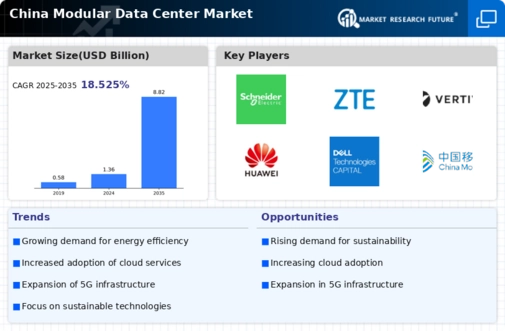Rising Demand for Edge Computing
The increasing demand for edge computing solutions is a pivotal driver for the modular data-center market. As businesses in China seek to enhance data processing capabilities closer to the source, modular data centers offer a flexible and efficient solution. The market is projected to grow at a CAGR of approximately 25% from 2025 to 2030, driven by the need for low-latency applications. This trend is particularly evident in sectors such as telecommunications and IoT, where real-time data processing is crucial. Modular data centers can be deployed rapidly, allowing companies to scale operations in response to fluctuating demands. This adaptability is essential in a fast-paced digital landscape, positioning modular data centers as a key component in the evolution of edge computing infrastructure.
Government Initiatives and Support
Government initiatives aimed at promoting digital infrastructure development are significantly impacting the modular data-center market. In China, policies encouraging the establishment of data centers in strategic locations are fostering growth in this sector. The government has introduced incentives for companies investing in modular data centers, including tax breaks and subsidies. These initiatives are designed to enhance the country's digital economy and improve overall connectivity. As a result, the modular data-center market is poised for expansion, with increased investments from both domestic and foreign entities. The supportive regulatory environment is likely to attract new players, further stimulating competition and innovation within the market.
Increased Focus on Energy Efficiency
Energy efficiency is becoming a critical concern for data center operators in China, driving the modular data-center market forward. With energy costs rising and environmental regulations tightening, companies are compelled to adopt more sustainable practices. Modular data centers are designed with energy efficiency in mind, often incorporating advanced cooling technologies and energy management systems. Reports indicate that these facilities can achieve energy savings of up to 40% compared to traditional data centers. This focus on sustainability not only helps organizations reduce operational costs but also aligns with China's broader environmental goals. As energy efficiency becomes a priority, the modular data-center market is expected to expand, catering to businesses aiming to minimize their carbon footprint.
Technological Integration and Innovation
The rapid pace of technological integration is a key driver for this market. In China, advancements in technologies such as artificial intelligence, machine learning, and big data analytics are influencing the design and functionality of modular data centers. These facilities are increasingly equipped with smart technologies that enhance operational efficiency and monitoring capabilities. The integration of IoT devices allows for real-time data collection and analysis, optimizing resource allocation and energy consumption. As organizations seek to leverage these technologies, the modular data-center market is likely to experience robust growth, with innovations that cater to the evolving needs of businesses across various sectors.
Cost Efficiency and Operational Flexibility
Cost efficiency remains a significant driver for the modular data-center market. In China, businesses are increasingly looking for ways to optimize operational expenditures while maintaining high performance. Modular data centers provide a cost-effective alternative to traditional data centers, with initial capital expenditures reduced by up to 30%. This is largely due to their prefabricated nature, which allows for quicker deployment and lower construction costs. Furthermore, the operational flexibility offered by modular designs enables companies to adjust their capacity based on current needs, thus avoiding over-provisioning. As organizations strive to enhance their return on investment, the modular data-center market is likely to see continued growth, particularly among small to medium-sized enterprises seeking scalable solutions.






















Leave a Comment